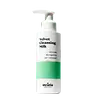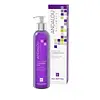What's inside
What's inside
 Key Ingredients
Key Ingredients

No key ingredients
 Benefits
Benefits

 Concerns
Concerns

 Ingredients Side-by-side
Ingredients Side-by-side

Water
Skin ConditioningOlive Oil PEG-7 Esters
EmollientCaprylic/Capric Triglyceride
MaskingOryza Sativa Bran Oil
EmollientGlycerin
HumectantCetearyl Alcohol
EmollientGlyceryl Stearate
EmollientPolyacrylamide
C13-14 Isoparaffin
EmollientLaureth-7
EmulsifyingCeteareth-20
CleansingChamomilla Recutita Flower Extract
MaskingAllantoin
Skin ConditioningAloe Barbadensis Leaf Juice
Skin ConditioningDisodium EDTA
Propylene Glycol
HumectantPotassium Sorbate
PreservativeDiazolidinyl Urea
PreservativeIodopropynyl Butylcarbamate
PreservativeWater, Olive Oil PEG-7 Esters, Caprylic/Capric Triglyceride, Oryza Sativa Bran Oil, Glycerin, Cetearyl Alcohol, Glyceryl Stearate, Polyacrylamide, C13-14 Isoparaffin, Laureth-7, Ceteareth-20, Chamomilla Recutita Flower Extract, Allantoin, Aloe Barbadensis Leaf Juice, Disodium EDTA, Propylene Glycol, Potassium Sorbate, Diazolidinyl Urea, Iodopropynyl Butylcarbamate
Aloe Barbadensis Leaf Juice
Skin ConditioningHelianthus Annuus Flower
Skin ConditioningGlycerin
HumectantCaprylic/Capric Triglyceride
MaskingPrunus Armeniaca Kernel Oil
MaskingPrunus Amygdalus Dulcis Protein
Skin ConditioningGlyceryl Laurate
EmollientGlyceryl Stearate
EmollientCetyl Alcohol
EmollientPrunus Amygdalus Dulcis Oil
Skin ConditioningResveratrol
AntioxidantUbiquinone
AntioxidantVitis Vinifera Seed
Skin ConditioningAllantoin
Skin ConditioningTocopherol
AntioxidantMangifera Indica Seed Oil
EmollientHibiscus Sabdariffa Callus Extract
AntioxidantBorago Officinalis Seed Oil
EmollientPhenethyl Alcohol
MaskingEthylhexylglycerin
Skin ConditioningAloe Barbadensis Leaf Juice, Helianthus Annuus Flower, Glycerin, Caprylic/Capric Triglyceride, Prunus Armeniaca Kernel Oil, Prunus Amygdalus Dulcis Protein, Glyceryl Laurate, Glyceryl Stearate, Cetyl Alcohol, Prunus Amygdalus Dulcis Oil, Resveratrol, Ubiquinone, Vitis Vinifera Seed, Allantoin, Tocopherol, Mangifera Indica Seed Oil, Hibiscus Sabdariffa Callus Extract, Borago Officinalis Seed Oil, Phenethyl Alcohol, Ethylhexylglycerin
 Reviews
Reviews

Ingredients Explained
These ingredients are found in both products.
Ingredients higher up in an ingredient list are typically present in a larger amount.
Allantoin is a soothing ingredient known for its protective and moisturizingg properties. Because of this, it is often added to products with strong active ingredients.
Studies show higher concentrations of this ingredient can promote wound healing.
Though it can be derived from the comfrey plant, allantoin is produced synthetically for cosmetic products to ensure purity.
Learn more about AllantoinAloe Barbadensis Leaf Juice comes from leaves of the aloe plant. Aloe Barbadensis Leaf Juice is best known for helping to soothe sunburns. It is also anti-inflammatory, moisturizing, antiseptic, and can help heal wounds.
Aloe is packed with good stuff including Vitamins A, C, and E. These vitamins are antioxidants, which help fight free-radicals and the damage they may cause. Free-radicals are molecules that may damage your skin cells, such as pollution.
Aloe Barbadensis Leaf Juice also contains sugars. These sugars come in the form of monosaccharides and polysaccharides, folic acid, and choline. These sugars are able to help bind moisture to skin.
It also contains minerals such as calcium, 12 anthraquinones, fatty acids, amino acids, and Vitamin B12.
Learn more about Aloe Barbadensis Leaf JuiceThis ingredient is an emollient, solvent, and texture enhancer. It is considered a skin-softener by helping the skin prevent moisture loss.
It helps thicken a product's formula and makes it easier to spread by dissolving clumping compounds.
Caprylic Triglyceride is made by combining glycerin with coconut oil, forming a clear liquid.
While there is an assumption Caprylic Triglyceride can clog pores due to it being derived from coconut oil, there is no research supporting this.
Learn more about Caprylic/Capric TriglycerideGlycerin is already naturally found in your skin. It helps moisturize and protect your skin.
A study from 2016 found glycerin to be more effective as a humectant than AHAs and hyaluronic acid.
As a humectant, it helps the skin stay hydrated by pulling moisture to your skin. The low molecular weight of glycerin allows it to pull moisture into the deeper layers of your skin.
Hydrated skin improves your skin barrier; Your skin barrier helps protect against irritants and bacteria.
Glycerin has also been found to have antimicrobial and antiviral properties. Due to these properties, glycerin is often used in wound and burn treatments.
In cosmetics, glycerin is usually derived from plants such as soybean or palm. However, it can also be sourced from animals, such as tallow or animal fat.
This ingredient is organic, colorless, odorless, and non-toxic.
Glycerin is the name for this ingredient in American English. British English uses Glycerol/Glycerine.
Learn more about GlycerinGlyceryl Stearate is a mix of glycerin and stearic acid.
It is used to stabilize the mixing of water and oil ingredients. By preventing these ingredients from separating, it can help elongate shelf life. It can also help thicken the product's texture.
As an emollient, it helps soften skin and supports barrier-replenishing ingredients.
In cosmetics, Glyceryl Stearate is often made from vegetable oils or synthetically produced.
This ingredient may not be fungal-acne safe
Fun fact: The human body also creates Glyceryl Stearate naturally.
Learn more about Glyceryl Stearate